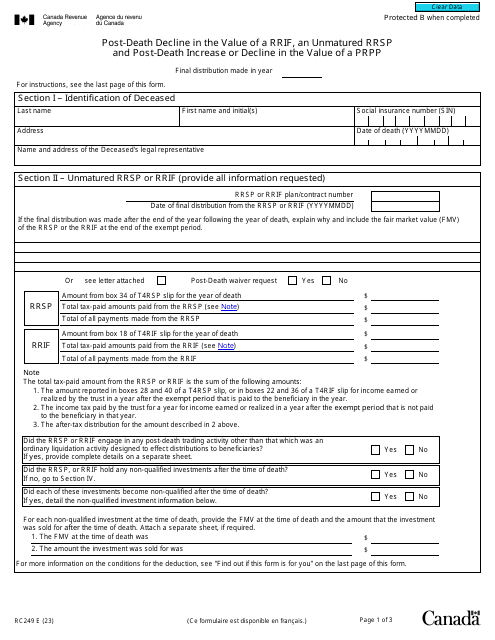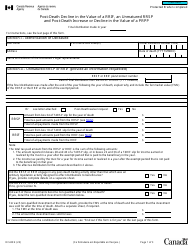Form RC249 Post-death Decline in the Value of a Rrif, an Unmatured Rrsp and Post-death Increase or Decline in the Value of a Prpp - Canada
The Form RC249 in Canada is used to report the post-death decline in the value of a Registered Retirement Income Fund (RRIF), an unmatured Registered Retirement Savings Plan (RRSP), and the post-death increase or decline in the value of a Pooled Registered Pension Plan (PRPP). It is used for tax purposes and helps calculate any tax implications resulting from these changes.
The form RC249 Post-death Decline in the Value of a RRIF, an Unmatured RRSP and Post-death Increase or Decline in the Value of a PRPP is filed by the deceased person's legal representative or estate trustee in Canada.
Form RC249 Post-death Decline in the Value of a Rrif, an Unmatured Rrsp and Post-death Increase or Decline in the Value of a Prpp - Canada - Frequently Asked Questions (FAQ)
Q: What is a Form RC249?
A: Form RC249 is a form used in Canada to report any post-death decline in value of a RRIF, an unmatured RRSP, or a post-death increase or decline in value of a PRPP.
Q: What is a RRIF?
A: RRIF stands for Registered Retirement Income Fund. It is a retirement income option in Canada where the funds in your RRSP are converted into regular payments to provide retirement income.
Q: What is an RRSP?
A: RRSP stands for Registered Retirement Savings Plan. It is a tax-advantaged savings account in Canada that allows individuals to save for their retirement.
Q: What is a PRPP?
A: PRPP stands for Pooled Registered Pension Plan. It is a type of pension plan in Canada that is designed to provide retirement income to employees of multiple employers.
Q: When should Form RC249 be used?
A: Form RC249 should be used when there is a post-death decline in the value of a RRIF, an unmatured RRSP, or a post-death increase or decline in the value of a PRPP.
Q: Who needs to fill out Form RC249?
A: The legal representative of the deceased individual's estate needs to fill out Form RC249.
Q: Are there any deadlines for submitting Form RC249?
A: Yes, there are specific deadlines for submitting Form RC249. It should be submitted within 180 days after the end of the year in which the post-death decline in value or increase or decline in value occurred.
Q: What information is required to fill out Form RC249?
A: The form requires information such as the deceased individual's name, social insurance number, the value of the RRIF, RRSP or PRPP at death, and details of the post-death decline or increase or decline in value.







